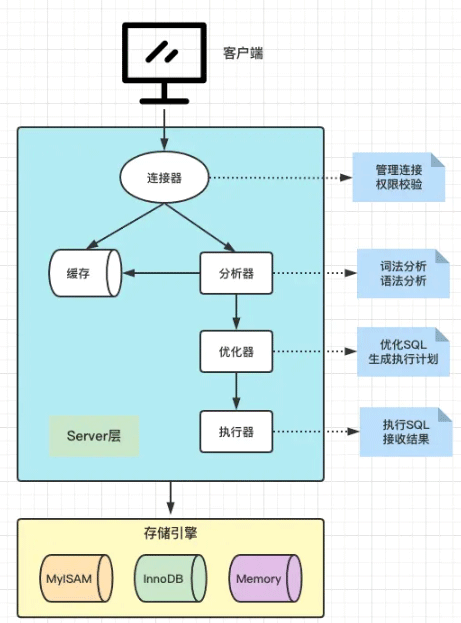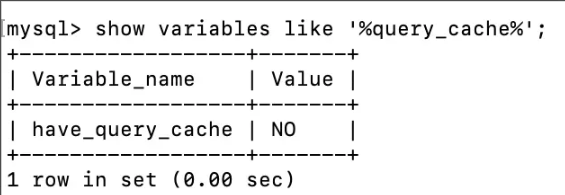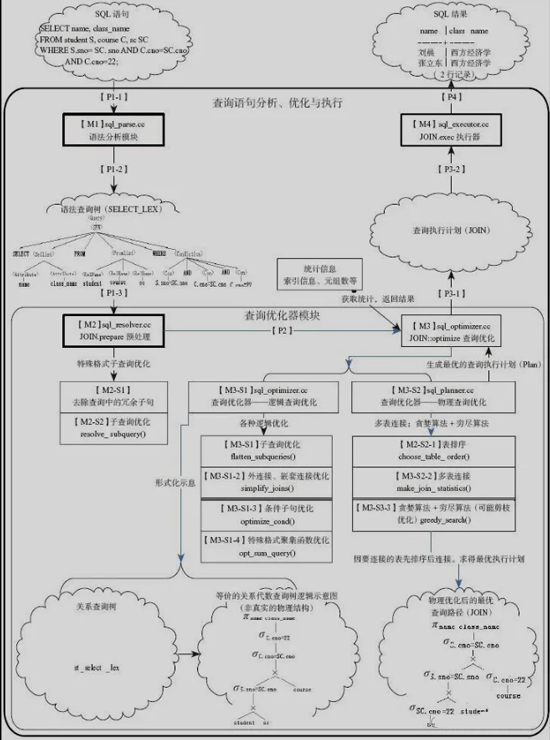MySQL architecture design example analysis
1. MySQL overall architecture
As you can see from the figure, the MySQL architecture is mainly divided into Server layer and Storage engine layer.
Server layer is divided into connectors, caches, analyzers, optimizers, and executors. All cross-storage engine functions are implemented in this layer, such as functions, stored procedures, triggers, views, etc.
Storage engine is pluggable. Common storage engines include MyISAM, InnoDB, Memory, etc. The default was MyISAM before MySQL5.5, and the default after that was InnoDB.

2. Connector
Connector is mainly used to manage client connections and user authentication.
TCP protocol is used for client-server connections. The connection is established by performing a TCP handshake, and based on this, the connector begins authentication.
> mysql -hlocalhost -P3306 -uroot -p
If authentication fails, an error will occur ERROR 1045 (28000): Access denied for user 'root'@'localhost' (using password: YES).
You can view the information of all connections in the system through the show processlist command:

The Commond column represents the connection status, and the Daemon represents the background process , Query represents query, and Sleep represents idle connection.
3. Query cache
The query requested by the client will not directly access the storage engine, but first check whether the result exists in the cache. If the result has been cached, return it directly; otherwise, re-execute the query process and cache the result after the query is completed.
The invalidation cache will be cleared when the data table changes, such as insert, update, delete, and alter operations.
For frequently changing data tables, the cache hit rate is very low. Because using cache will reduce read and write performance, the cache module was removed in versions after MySQL 8.0.
You can check whether the cache is enabled by running the following command:

4. Analyzer
The analyzer is mainly Perform lexical analysis and grammatical analysis on SQL statements.
For MySQL keywords and the meaning of each word, lexical analysis is required. Then perform syntax analysis to detect whether the SQL statement meets the MySQL syntax requirements.
MySQL identifies the column name, table name, where, select/update/insert and other MySQL keywords in the string, and determines whether the sql satisfies the grammar according to the grammar rules, and finally generates an abstract syntax tree (AST) .
For example: If you omit the where keyword in the SQL statement, an error will be prompted.
mysql> select * from user id=1; ERROR 1064 (42000): You have an error in your SQL syntax; check the manual that corresponds to your MySQL server version for the right syntax to use near '=1' at line 1
5. Optimizer
Before the SQL statement is actually executed, it needs to be processed by the optimizer.
The execution plan (Explain) we know well is generated by the optimizer.
The optimizer mainly has two functions: Logical optimization and Physical optimization.
Logical optimization mainly performs equivalent predicate rewriting, conditional simplification, subquery elimination, connection elimination, semantic optimization, group merging, selection pushdown, index optimization query, table query replacement view query, Union replacement or Operation etc.
Through the greedy algorithm and cost estimation model, the main purpose of physical optimization is to estimate the cost of each execution method. And use indexes to optimize table connections and finally generate query execution plans.
Attached is the MySQL optimizer architecture diagram, you can clearly see the optimization process:

6. Executor
After the optimizer optimizes the SQL and generates the execution plan, it will pass the execution plan to the executor.
The executor calls the storage engine interface to actually execute the SQL query. The execution of the SQL statement ends after obtaining the query results returned by the storage engine and returning them to the client.
The above is the detailed content of MySQL architecture design example analysis. For more information, please follow other related articles on the PHP Chinese website!

Hot AI Tools

Undresser.AI Undress
AI-powered app for creating realistic nude photos

AI Clothes Remover
Online AI tool for removing clothes from photos.

Undress AI Tool
Undress images for free

Clothoff.io
AI clothes remover

Video Face Swap
Swap faces in any video effortlessly with our completely free AI face swap tool!

Hot Article

Hot Tools

Notepad++7.3.1
Easy-to-use and free code editor

SublimeText3 Chinese version
Chinese version, very easy to use

Zend Studio 13.0.1
Powerful PHP integrated development environment

Dreamweaver CS6
Visual web development tools

SublimeText3 Mac version
God-level code editing software (SublimeText3)

Hot Topics
 1386
1386
 52
52
 MySQL: Simple Concepts for Easy Learning
Apr 10, 2025 am 09:29 AM
MySQL: Simple Concepts for Easy Learning
Apr 10, 2025 am 09:29 AM
MySQL is an open source relational database management system. 1) Create database and tables: Use the CREATEDATABASE and CREATETABLE commands. 2) Basic operations: INSERT, UPDATE, DELETE and SELECT. 3) Advanced operations: JOIN, subquery and transaction processing. 4) Debugging skills: Check syntax, data type and permissions. 5) Optimization suggestions: Use indexes, avoid SELECT* and use transactions.
 How to open phpmyadmin
Apr 10, 2025 pm 10:51 PM
How to open phpmyadmin
Apr 10, 2025 pm 10:51 PM
You can open phpMyAdmin through the following steps: 1. Log in to the website control panel; 2. Find and click the phpMyAdmin icon; 3. Enter MySQL credentials; 4. Click "Login".
 MySQL: An Introduction to the World's Most Popular Database
Apr 12, 2025 am 12:18 AM
MySQL: An Introduction to the World's Most Popular Database
Apr 12, 2025 am 12:18 AM
MySQL is an open source relational database management system, mainly used to store and retrieve data quickly and reliably. Its working principle includes client requests, query resolution, execution of queries and return results. Examples of usage include creating tables, inserting and querying data, and advanced features such as JOIN operations. Common errors involve SQL syntax, data types, and permissions, and optimization suggestions include the use of indexes, optimized queries, and partitioning of tables.
 How to use single threaded redis
Apr 10, 2025 pm 07:12 PM
How to use single threaded redis
Apr 10, 2025 pm 07:12 PM
Redis uses a single threaded architecture to provide high performance, simplicity, and consistency. It utilizes I/O multiplexing, event loops, non-blocking I/O, and shared memory to improve concurrency, but with limitations of concurrency limitations, single point of failure, and unsuitable for write-intensive workloads.
 Why Use MySQL? Benefits and Advantages
Apr 12, 2025 am 12:17 AM
Why Use MySQL? Benefits and Advantages
Apr 12, 2025 am 12:17 AM
MySQL is chosen for its performance, reliability, ease of use, and community support. 1.MySQL provides efficient data storage and retrieval functions, supporting multiple data types and advanced query operations. 2. Adopt client-server architecture and multiple storage engines to support transaction and query optimization. 3. Easy to use, supports a variety of operating systems and programming languages. 4. Have strong community support and provide rich resources and solutions.
 MySQL's Place: Databases and Programming
Apr 13, 2025 am 12:18 AM
MySQL's Place: Databases and Programming
Apr 13, 2025 am 12:18 AM
MySQL's position in databases and programming is very important. It is an open source relational database management system that is widely used in various application scenarios. 1) MySQL provides efficient data storage, organization and retrieval functions, supporting Web, mobile and enterprise-level systems. 2) It uses a client-server architecture, supports multiple storage engines and index optimization. 3) Basic usages include creating tables and inserting data, and advanced usages involve multi-table JOINs and complex queries. 4) Frequently asked questions such as SQL syntax errors and performance issues can be debugged through the EXPLAIN command and slow query log. 5) Performance optimization methods include rational use of indexes, optimized query and use of caches. Best practices include using transactions and PreparedStatemen
 MySQL and SQL: Essential Skills for Developers
Apr 10, 2025 am 09:30 AM
MySQL and SQL: Essential Skills for Developers
Apr 10, 2025 am 09:30 AM
MySQL and SQL are essential skills for developers. 1.MySQL is an open source relational database management system, and SQL is the standard language used to manage and operate databases. 2.MySQL supports multiple storage engines through efficient data storage and retrieval functions, and SQL completes complex data operations through simple statements. 3. Examples of usage include basic queries and advanced queries, such as filtering and sorting by condition. 4. Common errors include syntax errors and performance issues, which can be optimized by checking SQL statements and using EXPLAIN commands. 5. Performance optimization techniques include using indexes, avoiding full table scanning, optimizing JOIN operations and improving code readability.
 Monitor Redis Droplet with Redis Exporter Service
Apr 10, 2025 pm 01:36 PM
Monitor Redis Droplet with Redis Exporter Service
Apr 10, 2025 pm 01:36 PM
Effective monitoring of Redis databases is critical to maintaining optimal performance, identifying potential bottlenecks, and ensuring overall system reliability. Redis Exporter Service is a powerful utility designed to monitor Redis databases using Prometheus. This tutorial will guide you through the complete setup and configuration of Redis Exporter Service, ensuring you seamlessly build monitoring solutions. By studying this tutorial, you will achieve fully operational monitoring settings




